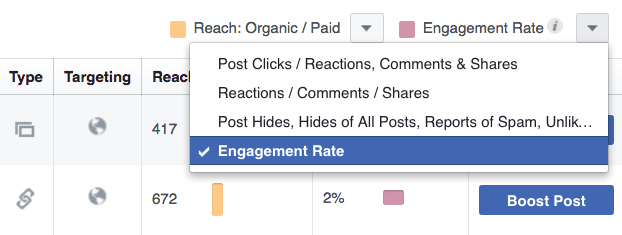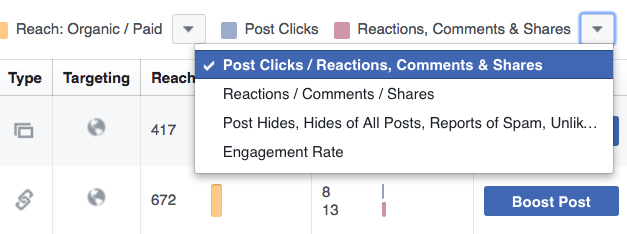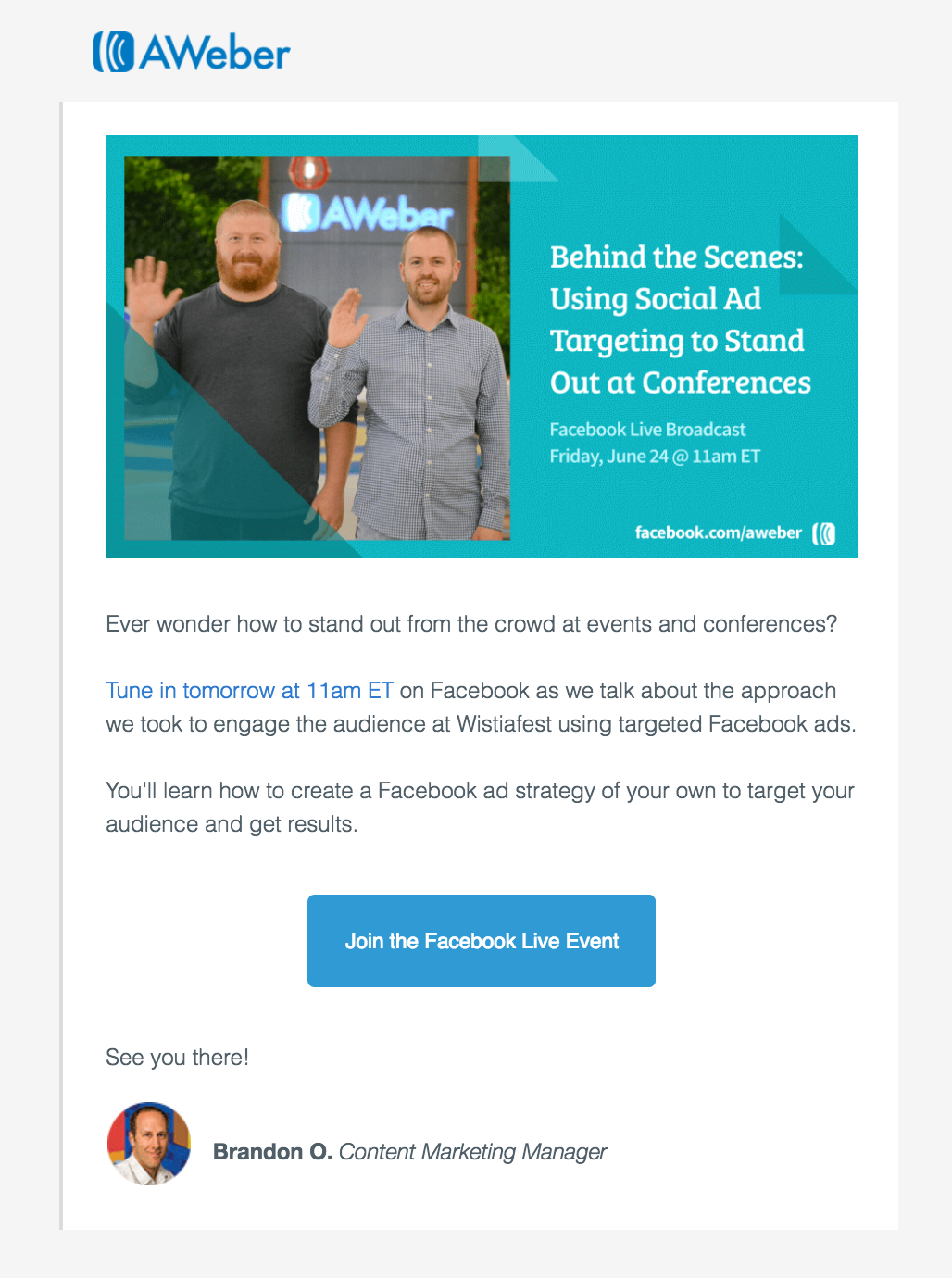Writing consistent, unique emails for your subscribers can be hard, and it’s often a struggle many email marketers face. (Don’t worry, it happens to the best of us!)
While there’s no shortage of places to look for ideas on what to write, we often overlook one of the best sources available to us: Facebook.
Facebook is a great place to test ideas in real-time since it provides an environment that makes it easy to figure out what content resonates with your audience – which can speak volumes to the type of content that would be relevant to your email subscribers.
By monitoring the performance of your Facebook content using Facebook Insights, you can see what content works and what doesn’t for not only your Facebook audience, but also your email subscribers.
Keep reading to learn some unique ways to use your Facebook stats to improve your email content.
Step 1: Identify your most engaging Facebook content
The first step in using your Facebook insights to better your email content is to first identify your most engaging content.
To find your most engaging Facebook posts, look at your overall engagement rate per post. This is calculated by combining all interactions on your post, including likes, reactions, comments, shares and clicks, and dividing the total interactions by the total reach of your post.

You want to focus on your engagement rate because it tells you what your engagement is in relation to how many people saw it. Looking at the number of likes, reactions, comments and shares on their own will not give you a true sense of the engagement on your posts.
Here’s why: Let’s say one of your Facebook posts received five likes and another received 10 likes. On the surface, you may think that the one that received 10 likes was more engaging. But you’re missing an important factor in the equation: the number of people who saw your post.
What if the one with 10 likes was seen by 500 people? That gives you a two percent engagement rate. And what if the one with five likes was seen by 50 people? That gives you a 10 percent engagement rate. So the one with five likes was actually more engaging.
Step 2: Consider why this content is engaging
Once you’ve identified your best-performing Facebook posts, it’s time to do a high-level review of the content. Start by asking yourself these questions:
What was the topic?
What type or format of content was it? Photo, video, link? Was it a how-to, listicle, or something more abstract?
What was the tone of the post? Serious, quirky, humorous, friendly?
What was unique about it? What was different about that post that caused more people to engage with it?
Be sure to jot down this information somewhere so you can refer to it later.
Now it’s time to dig deeper and look at the specific ways people interacted with your content so you can draw more conclusions.
There are a four ways people can engage with your Facebook content that I’m going to focus on (which happen to be listed in the image below).

1. Likes or Reactions
A like or reaction is the most passive way of interacting with your content, as it requires a mere second of someone’s time. But there is value you can draw from this type of interaction.
If your post received a lot of likes or reactions, but not comments, shares or clicks, it tells you that people were willing to express how they felt about the content, but it may not have been meaningful enough to discuss or share with friends.
Here’s a Facebook post from Product Hunt, where they announce Wal-Mart’s acquisition of Jet. It got a lot of love from their Facebook fans likely due to its fun and light-hearted approach.

This Facebook post from Buffer below does a fantastic job of talking about their product in a fun way, and it’s something any Buffer user can relate to. And Buffer fans did not disappoint – they showed exactly how they felt with their likes and reactions.

2. Comments
A comment is when someone posts a response to your Facebook content. It’s a much more meaningful type of interaction because it shows that someone is willing to take part in a discussion.
If your post had a lot of comments, it means people have strong opinions about the topic and are willing to share them. You can use this type of post to create email content that encourages people to reply with their opinions, take a survey, or start a discussion in a Slack or Facebook group.
We did a Facebook Live event recently where we shared some tips on using social media to build your email audience. We were quite surprised to see the number of comments the video received, and it became obvious that our audience was looking for more info on social media list-building techniques. (Psst – if you want more info, we just released our new Essentials to Email + Social ebook and course!)
3. Shares
A share is anytime someone intentionally shares your Facebook post with their friends. This is different than a like, reaction or comment because those are all done without the intention of shining a spotlight on your Facebook post.
Most people share content that represents them, their interests, their views – basically, how they want others to view or perceive them. But keep in mind that people sometimes share your content with bad intentions (e.g., “Can you believe this?”). So be careful not to assume that just because you got a lot of shares, it’s a good thing.
If a post has a high number of shares, consider including it in an email and asking people to forward it to friends.
This Facebook post got Buffer fans sharing the love with their friends and connections:
4. Clicks
A click is when someone clicks a link within your post, which tells you people are interested in learning more.
Your content may not elicit a public reaction, but it does show you that people are interested in the topic or content.
A low amount of clicks but a high level of public reaction tells you that your content delighted them but it wasn’t appealing enough to consume more.
This post we recently published was on a new topic we hadn’t written about before, but by looking at the click data and seeing that it received more clicks than other posts, it was clear it is something people are interested in learning more about.
Step 3: Apply what you learn to your emails
Once you feel confident you know why your posts were engaging, it’s time to apply what you’ve learned to the various components of your email content.
Let’s explore some of the unique ways you can use what you’ve learned from your Facebook content and apply it to your emails.
Subject line
Your subject line is the first thing people see in their inbox, so it has an important job. It’s sole purpose is to get people to open your email, whether that’s through creating interest or delighting them.
To come up with a winning subject line, start by looking at your popular topics, formats (e.g., video, photos, downloads, etc.), and tones (e.g., serious, quirky, humorous, friendly), and incorporating those into your subject line.
Fun fact: Using the word “video” in an email subject line can boost open rates by 19 percent, click-through rates by 65 percent, and reduces unsubscribes by 26 percent.
Here’s a Facebook post that performed really well for us:

I suspect the words “first-ever app” and “create and send from your mobile device” struck a chord with our Facebook fans and customers.
So if I were to email this content to our subscribers, my subject line might be one of the following:
Create and send emails from the palm of your hand
You can now create and send emails from your mobile device
AWeber’s first-ever mobile app to create and send curated emails
When creating an engaging subject line, you can take any number of approaches. But the most successful ones make it very clear what someone will find when they open your email.
Here are some subject line ideas based on the Product Hunt example mentioned earlier:
Walmart is buying this two-year old startup for $3 billion
Did you hear the rumors about Walmart’s recent acquisition?
Walmart just threw $3 billion at this 2-year-old startup!
This 2-year-old startup was just bought for $3 billion!
Also, be sure to consider the length of your subject line. Try to keep your subject lines to 25-50 characters, and put the most important content of the subject line within the first 38 characters so it displays on most mobile devices.
Body of your email
Once someone opens your email, you’ve got to grab their attention right away, so what you put in your email matters.
For the length of your emails, try to stick to one to three paragraphs that contain 75-150 characters each.
Typically, video and images get the most engagement on Facebook. So naturally, using videos and images in the body of your emails is an effective way to engage your email subscribers.
Fun fact: Sixty-five percent of people like emails that are mostly made up of images and video in an email leads to a 200-300 percent increase in click-through rates.
Let’s look at an example. Here’s a post promoting an event that got some good engagement:

From this, I can assume that the animated GIF grabbed people’s attention, was delightful and funny and elicited reactions from our fans.
When creating my email, my goal would be to elicit the same reaction from our subscribers. So my email could look something like this:

Adding videos to emails isn’t as straightforward as you might think. Many email providers don’t allow videos to play within emails. So to create the illusion of video in your emails, you can either create a still image that looks like a video (with the play button and all), or an animated GIF that has some motion. Or you can add a video to your email using AWeber’s easy drag-and-drop editor. All of these options can direct subscribers to a hosted video once clicked.
If you need some help creating an engaging video or image, check out our step-by-step checklists:
Record your first YouTube video
Design your first shareable image
Calls to Action
The body of your email should also have a primary call to action (CTA). Try to stay within 20-40 characters for your CTAs.
Here’s a Facebook post promoting our free email writing course and templates:
This post received a good amount of clicks, likely due to the straightforward nature of the headline as well as the benefit-focused copy of the post.
So if I were to apply my learnings from this Facebook to my email CTA, I might use one of the following CTAs:
“Send Better Emails Today”
“Start Sending Smarter Emails”
“Get Smarter with my Emails”
“Start My Free Writing Course”
Or if we look at the Facebook Live event I mentioned earlier, here are some potentials CTAs to include in an email:
Join the conversation
Join the discussion
Share your thoughts
Weigh in with your input
Connecting your marketing stats
It’s easy to get focused on specific marketing channels and compartmentalize your efforts. But I encourage you to take a step back and look at the bigger picture: There are lessons you can learn in one marketing channel that you can apply to your other marketing efforts.
While this post focused on using Facebook Insights to improve your email content, the same can be true for using your email stats to improve your Facebook content or other marketing efforts. The sky’s the limit!
What lessons will you apply to your marketing efforts? Share in the comments below.
Posted By
Brandon Olson
Content Marketing Manager

No comments:
Post a Comment